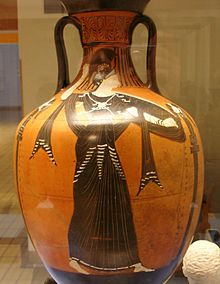 The original Acoma pueblo claims to be the oldest, continuously occupied settlement in the United States. The Acoma line of pottery can be traced back to 1750.
The original Acoma pueblo claims to be the oldest, continuously occupied settlement in the United States. The Acoma line of pottery can be traced back to 1750.
Peru

Peru, Cuzco 1530's
Wednesday, February 23, 2011
Acome Pueblo Pottery
 The original Acoma pueblo claims to be the oldest, continuously occupied settlement in the United States. The Acoma line of pottery can be traced back to 1750.
The original Acoma pueblo claims to be the oldest, continuously occupied settlement in the United States. The Acoma line of pottery can be traced back to 1750.
Monday, February 21, 2011
 Northern Song (960-1127) 11th century Porcelain-like stoneware with céladon feldspathic glaze. The height is about 20.5 cm. I thought that this piece is very interesting because of the color of the glaze of the pottery. The details of the container is very intricate and detailed. It's just an interesting piece overall.
Northern Song (960-1127) 11th century Porcelain-like stoneware with céladon feldspathic glaze. The height is about 20.5 cm. I thought that this piece is very interesting because of the color of the glaze of the pottery. The details of the container is very intricate and detailed. It's just an interesting piece overall.
Anciet Greek Pottery

This piece of pottery is from 520 BC Greece. This piece has no glaze yet it stills appear to have a shiny tinge to it. This might be slip. I am amazed by the detailed intricacies of the design around the picture, especially on the handles. I really like the separate shapes that make up the vase from the rim to the foot.
Friday, February 18, 2011
Nazca Pottery (6th century)
 This is a South American piece made by the Nazca and it's a pot in the form of a fish with a double spout handle. Nazca is characterized by their polychrome pottery and use a variety of colors when creating a piece. Back then, the Nazca didn't have a writing system and instead used symbols in ceramic pieces as a mean of communication.
This is a South American piece made by the Nazca and it's a pot in the form of a fish with a double spout handle. Nazca is characterized by their polychrome pottery and use a variety of colors when creating a piece. Back then, the Nazca didn't have a writing system and instead used symbols in ceramic pieces as a mean of communication.
Blackware pottery, 1200 BC

Olmec culture, Las Bocas, Puebla, Mexico, ca. 1200-900 B.C. Blackware pottery vessel of simple form with stylized symbolic quadripartite designs separated by bisected panels, red pigment highlights Olmec art was created to give power to the shaman and the shaman/ruler. Ceramics, for example, were fashioned of clay, which was coaxed into meaningful forms which would become the property and the containers of sacred substances of the important shamans.
Thursday, February 17, 2011
Egyptian Pottery

This piece originated from Egypt during the Naqada II, Predynastic period. This period is supposedly one of the most significant predynastic cultures in Egyptian history. The jar was made around 3650-3300 B.C. During that time, artists had developed new styles and techniques, which included more detailed carving. These new adaptations could have came from neighboring countries or trading partners. Capturing animals on the pottery also seemed to be very popular. The jar has a height of thirty centimeters and a diameter of thirty centimeters as well.
http://library.artstor.org/library/iv2.html?parent=true#
http://www.mnsu.edu/emuseum/prehistory/egypt/history/dynasties/late.html
http://www.ancientegyptonline.co.uk/predynlist.html
Tuesday, February 15, 2011
Mochica

This piece was created in Lampayaque, Peru, between the years of 1-800 A.D. and from the Mochica civilization. Their ceramics are known for being the "lightest and finest terracotta's ever made in ancient Peru and probably the world." Their ceramics depicted various social activities including war, sex, metal work, and weaving. Another aspect of Mochica art is their great attention to detail. Through life-like vases, portraits, figures, and paintings, their artwork suggests creativity and individuality playing an important part of the Mochica culture.
Monday, February 14, 2011
Korean Pottery

The Koryo Dynasty, which lasted from 918 to 1392 AD, had a strong Buddhist influence which shaped many of its cultural achievements. In the middle of the 10th century Korean artists, some who had been schooled in China began creating celadon by using inlay and copper glazing techniques which were developed first in China but only fully developed and perfected by Korean artisans. The level of fine quality and beauty they were able to achieve in their work surpassed that of other countries and came to be revered by even the Chinese for its elegant, yet simple beauty. The Koryo Royal Court also used some of the finest examples of celadon pottery in their palaces both as vessels for daily use and as objects of fine art.
Panathenaic amphora


These two vases are examples of panathenaic amphora from ancient Greek times. These vases were used to hold olive oil and were given to the winners of the Panathenaic Games. These games were held every four years in Ancient Greece. Usually, pictures of Athena, the goddess of war, were painted on it. These vases appeared after 530 BC. The one on the right is from 565 BCE.
Canopic Jars
This is a canopic jar. Egyptian pharaohs were buried with canopic jars (usually four) holding their internal organs, protecting them for the afterlife. They were usually created from pottery but sometimes made by carving limestone, and topped with a decoratively painted wooden head. These canopic jars are on display at the British Museum, and held the remains of Neskhons (wife of a High Priest in Upper Egypt), 990 - 969 BC.
-Melissa Shohet
-Melissa Shohet
Friday, February 11, 2011
Greek Pottery 550-300B.C.
Greek Pottery 550-300B.C.
Tuesday, February 8, 2011
Bowl with a Rabbit Carrying a Strawberry in Its Mouth
Subscribe to:
Comments (Atom)





